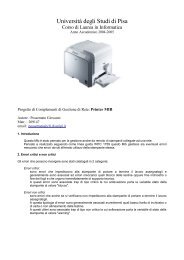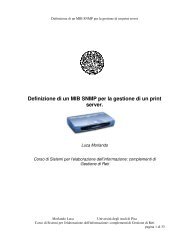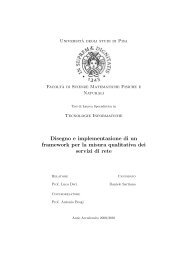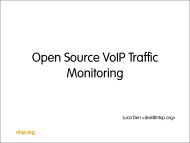vPF_RING: Towards Wire-Speed Network ... - Luca Deri - Ntop
vPF_RING: Towards Wire-Speed Network ... - Luca Deri - Ntop
vPF_RING: Towards Wire-Speed Network ... - Luca Deri - Ntop
You also want an ePaper? Increase the reach of your titles
YUMPU automatically turns print PDFs into web optimized ePapers that Google loves.
processes making Linux unaware of dealing with a virtual<br />
system.<br />
<strong>vPF</strong>_<strong>RING</strong>, described later in section 3.2, does not strictly<br />
depend on KVM but it mostly relies on PF_<strong>RING</strong> APIs.<br />
Instead, as described in the next section, the vNPlug<br />
framework has been designed on top of KVM for<br />
implementing the hypervisor-bypass approach (mapping<br />
memory, exchanging control messages, notifying events).<br />
Porting vNPlug to another hypervisor such as Xen, requires<br />
a complete code rewrite, contrary to the <strong>vPF</strong>_<strong>RING</strong> code<br />
that should not be modified.<br />
3.1 vNPlug Framework<br />
The vNPlug framework exploits the hypervisor-bypass<br />
approach for achieving high packet capture performance in<br />
virtualized environments. It has been designed to be<br />
general enough for being used by every monitoring<br />
application and not just <strong>vPF</strong>_<strong>RING</strong>. For instance, the<br />
Linux native socket type PF_PACKET is quite similar to<br />
PF_<strong>RING</strong> as both use memory mapped buffers to exchange<br />
packets between kernel and user-space. Porting<br />
PF_PACKET on top of <strong>vPF</strong>_<strong>RING</strong>-vNPlug is thus just a<br />
matter of time as it does not seem to have any technical<br />
challenge being the two socket types pretty similar.<br />
The framework follows a paravirtualization-like design,<br />
guests are aware of being virtualized and consequently the<br />
architecture is logically split in a guest and an host side<br />
block.<br />
The framework is logically divided into two main<br />
components. The first component, vNPlug-Dev, is<br />
responsible for:<br />
• Mapping memory between the host kernel-space and the<br />
guest user-space.<br />
• Implementing an efficient event notification that is<br />
necessary for VM/Host communications.<br />
The second component, vNPlug-CTRL, is responsible for<br />
coordinating the host and guest side of applications by<br />
means of a control communication channel. The channel is<br />
required, for example, when an application needs to<br />
instrument its host-side back-end for filtering specific<br />
packets.<br />
As can be seen, applications built on top of the framework<br />
can access physical host resources that are usually not<br />
available in virtualized environments. In case of<br />
<strong>vPF</strong>_<strong>RING</strong>, applications executed under VMs can capture<br />
packets not only from VM’s network interfaces, but also<br />
from physical host interfaces. This feature can be offered<br />
by building <strong>vPF</strong>_<strong>RING</strong> on top of the vNPlug framework.<br />
vNPlug is implemented as a QEMU patch on the host side,<br />
and a Linux kernel module (vnplug.ko), based on both<br />
vNPlug-Dev and vNPlug-CTRL components, on the guest<br />
OS.<br />
3.1.1 vNPlug-Dev<br />
The original PF_<strong>RING</strong> maps kernel ring buffers to userspace<br />
via memory-map. vNPlug-Dev allows to further<br />
memory-map these virtual memory areas to virtual<br />
machines. The initial memory-mapping happens through<br />
the hypervisor, whereas all packets are exchanged directly<br />
between the VM and the PF_<strong>RING</strong> sitting on the host<br />
without any hypervisor support. This mapping is performed<br />
dynamically attaching additional blocks of memory via<br />
virtual PCI devices whenever a <strong>vPF</strong>_<strong>RING</strong> is created.<br />
Inside the VM, these memory regions can be accessed by<br />
ioremap(), and mapped in virtual memory areas via the<br />
vnplug.ko kernel module that creates character devices that<br />
can be memory-mapped. Figure 7 depicts the vNPlug-Dev<br />
architecture.<br />
QEMU<br />
Application<br />
backend<br />
mmap()<br />
In-kernel<br />
App. backend<br />
vNPlug-Dev<br />
qemu_ram_alloc_from_ptr()<br />
mmap()<br />
Application<br />
vNPlug-Dev<br />
vNPlug-Dev<br />
Virtual Device<br />
irqfd ioeventfd<br />
Figure 7. vNPlug-Dev Architecture<br />
Guest<br />
userspace<br />
kernel<br />
KVM<br />
Host Kernel<br />
vNPlug-Dev is dynamic by design as it allows dynamic<br />
memory-mapping to take place by means of virtual PCI<br />
devices. Therefore, the number of rings is not limited as it<br />
happens, for instance, in BSD systems where packets are<br />
captured from a limited number of statically allocated<br />
capture devices (/dev/bpfX).<br />
The PCI hotplug support allows devices to be dynamically<br />
attached and removed from a running system. Even if<br />
hotplug is rarely used in practice, basic hotplug support is<br />
provided by the majority of modern operating systems,<br />
making hot-plugged devices immediately usable with<br />
limited effort. By exploiting the hotplug, it is possible to<br />
dynamically attach memory mappings to guests whenever<br />
necessary, making <strong>vPF</strong>_<strong>RING</strong> a very flexible system that<br />
does not have any limitation in terms of functionality and<br />
flexibility with respect to native PF_<strong>RING</strong>.<br />
The event signaling functionality of the framework takes<br />
advantage of the irqfd and ioeventfd supports of KVM in<br />
order to provide a two-way notification mechanism, from<br />
host-to-guest and from guest-to-host. Both of them are<br />
based on the eventfd file descriptor for event notification,<br />
that is quite powerful yet flexible as it can be used from<br />
both user-space and kernel-space in order to signal/wait<br />
events.<br />
Using the irqfd support it is possible to send interrupts to<br />
the VM without passing through the QEMU process, which






